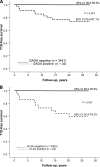Prediction of type 1 diabetes in the general population
- PMID: 20508230
- PMCID: PMC2875424
- DOI: 10.2337/dc09-1040
Prediction of type 1 diabetes in the general population
Abstract
Objective: To evaluate the utility of GAD antibodies (GADAs) and islet antigen-2 antibodies (IA-2As) in prediction of type 1 diabetes over 27 years in the general population and to assess the 6-year rates of seroconversion.
Research design and methods: A total of 3,475 nondiabetic subjects aged 3-18 years were sampled in 1980, and 2,375 subjects (68.3%) were resampled in 1986. All subjects were observed for development of diabetes to the end of 2007. GADAs and IA-2As were analyzed in all samples obtained in 1980 and 1986.
Results: A total of 34 individuals (1.0%; 9 developed diabetes) initially had GADAs and 22 (0.6%; 9 developed diabetes) IA-2As. Seven subjects (0.2%) tested positive for both autoantibodies. The positive seroconversion rate over 6 years was 0.4% for GADAs and 0.2% for IA-2As, while the inverse seroconversion rates were 33 and 57%, respectively. Eighteen subjects (0.5%) developed type 1 diabetes after a median pre-diabetic period of 8.6 years (range 0.9-20.3). Initial positivity for GADAs and/or IA-2As had a sensitivity of 61% (95% CI 36-83) for type 1 diabetes. Combined positivity for GADAs and IA-2As had both a specificity and a positive predictive value of 100% (95% CI 59-100).
Conclusions: One-time screening for GADAs and IA-2As in the general childhood population in Finland would identify approximately 60% of those individuals who will develop type 1 diabetes over the next 27 years, and those subjects who have both autoantibodies carry an extremely high risk for diabetes. Both positive and inverse seroconversions do occur over time reflecting a dynamic process of beta-cell autoimmunity.
Figures


Comment in
-
Enhancing the understanding of pre-type 1 diabetes in the general population.Diabetes Care. 2010 Jun;33(6):1403-5. doi: 10.2337/dc10-0566. Diabetes Care. 2010. PMID: 20508234 Free PMC article. No abstract available.
Similar articles
-
Autoantibodies to a 38-kDa glycosylated islet cell membrane-associated antigen in (pre)type 1 diabetes: association with IA-2 and islet cell autoantibodies.Diabetes Care. 2001 Jul;24(7):1181-6. doi: 10.2337/diacare.24.7.1181. Diabetes Care. 2001. PMID: 11423499
-
Islet cell antibodies are less predictive of IDDM among unaffected children in the general population than in sibs of children with diabetes. The Childhood Diabetes in Finland Study Group.Diabetes Care. 1998 Oct;21(10):1670-3. doi: 10.2337/diacare.21.10.1670. Diabetes Care. 1998. PMID: 9773728
-
Genetic risk determines the emergence of diabetes-associated autoantibodies in young children.Diabetes. 2002 Mar;51(3):646-51. doi: 10.2337/diabetes.51.3.646. Diabetes. 2002. PMID: 11872662
-
Characterisation of rapid progressors to type 1 diabetes among children with HLA-conferred disease susceptibility.Diabetologia. 2017 Jul;60(7):1284-1293. doi: 10.1007/s00125-017-4258-7. Epub 2017 Mar 31. Diabetologia. 2017. PMID: 28364254
-
Time-resolved immunofluorometric dual-label assay for simultaneous detection of autoantibodies to GAD65 and IA-2 in children with type 1 diabetes.Clin Chem. 2007 Mar;53(3):472-9. doi: 10.1373/clinchem.2005.064568. Epub 2007 Jan 26. Clin Chem. 2007. PMID: 17259239
Cited by
-
Reclassification of asymptomatic beta cell autoimmunity: a critical perspective.Diabetologia. 2017 Jan;60(1):39-42. doi: 10.1007/s00125-016-4147-5. Epub 2016 Oct 27. Diabetologia. 2017. PMID: 27787620
-
Pancreas Volume Declines During the First Year After Diagnosis of Type 1 Diabetes and Exhibits Altered Diffusion at Disease Onset.Diabetes Care. 2019 Feb;42(2):248-257. doi: 10.2337/dc18-1507. Epub 2018 Dec 14. Diabetes Care. 2019. PMID: 30552135 Free PMC article. Clinical Trial.
-
Serum biomarkers for diagnosis and prediction of type 1 diabetes.Transl Res. 2018 Nov;201:13-25. doi: 10.1016/j.trsl.2018.07.009. Epub 2018 Aug 1. Transl Res. 2018. PMID: 30144424 Free PMC article. Review.
-
Risk of type 1 diabetes progression in islet autoantibody-positive children can be further stratified using expression patterns of multiple genes implicated in peripheral blood lymphocyte activation and function.Diabetes. 2014 Jul;63(7):2506-15. doi: 10.2337/db13-1716. Epub 2014 Mar 4. Diabetes. 2014. PMID: 24595351 Free PMC article.
-
Stopping type 1 diabetes: attempts to prevent or cure type 1 diabetes in man.Diabetes. 2011 Jan;60(1):1-8. doi: 10.2337/db10-1114. Diabetes. 2011. PMID: 21193733 Free PMC article. No abstract available.
References
-
- Atkinson MA, Eisenbarth GS: Type 1 diabetes: new perspectives on disease pathogenesis and treatment. Lancet 2001;358:221–229 - PubMed
-
- Knip M: Disease-associated autoimmunity and prevention of insulin-dependent diabetes mellitus. Ann Med 1997;29:447–451 - PubMed
-
- Bonifacio E, Genovese S, Braghi S, Bazzigaluppi E, Lampasona V, Bingley PJ, Rogge L, Pastore MR, Bognetti E, Bottazzo GF, Gale EAM, Bosi E: Islet autoantibody markers in IDDM: risk assessment strategies yielding high sensitivity. Diabetologia 1995;38:816–822 - PubMed
-
- Verge C, Gianani R, Kawasaki E, Yu L, Pietropaolo M, Jackson RA, Chase HP, Eisenbarth GS: Prediction of type 1 diabetes in first-degree relatives using a combination of insulin, GAD, and ICA512bdc/IA-2 autoantibodies. Diabetes 1996;45:926–933 - PubMed
-
- Kulmala P, Savola K, Petersen JS, Vähäsalo P, Karjalainen J, Löppönen T, Dyrberg T, Åkerblom HK, Knip M: the Childhood Diabetes in Finland Study Group Prediction of insulin-dependent diabetes mellitus in siblings of children with diabetes: a population-based study. J Clin Invest 1998;101:327–336 - PMC - PubMed
Publication types
MeSH terms
Substances
LinkOut - more resources
Full Text Sources
Other Literature Sources
Medical

